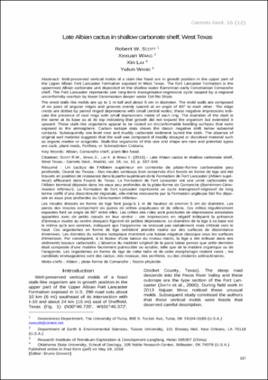| dc.contributor.author | Scott, Robert W. | |
| dc.contributor.author | Wang, Xexuan | |
| dc.contributor.author | Lai, Xin | |
| dc.contributor.author | Wang, Yulun | |
| dc.date.accessioned | 2019-08-21T22:01:30Z | |
| dc.date.available | 2019-08-21T22:01:30Z | |
| dc.date.issued | 2016-05-19 | |
| dc.identifier | oksd_scott_latealbiancact_2016 | |
| dc.identifier.citation | Scott, R. W., Wang, X., Lai, X., & Wang, Y. (2016). Late Albian cactus in shallow carbonate shelf, West Texas. Carnets de Geologie, 16(12). https://doi.org/10.4267/2042/60122 | |
| dc.identifier.uri | https://hdl.handle.net/11244/321202 | |
| dc.description.abstract | Well-preserved vertical molds of a stalk-like fossil are in growth position in the upper part of the Upper Albian Fort Lancaster Formation exposed in West Texas. The Fort Lancaster Formation is the uppermost Albian carbonate unit deposited on the shallow water Barremian-early Cenomanian Comanche shelf. The Fort Lancaster represents one long-term transgressive-regressive cycle capped by a regional unconformity overlain by lower Cenomanian deeper water Del Rio Shale. The erect stalk-like molds are up to 1 m tall and about 6 cm in diameter. The mold walls are composed of six pairs of angular ridges and grooves evenly spaced at an angle of 60° to each other. The ridge crests are dotted by paired ringed depressions with small central nodes; these negative impressions indicate the presence of oval rings with small depressions inside of each ring. The diameter of the stalk is the same at its base as at its top indicating that growth did not expand the organism but extended it upward. These stalk-like organisms appear to be rooted on disconformable bedding surfaces that were exposed to the atmosphere. Carbon isotope data shows the classic negative shift below subaerial contacts. Subsequently sea level rose and muddy carbonate sediment buried the stalk. The absence of original wall material suggests that the wall was composed of readily decayed or dissolved material such as organic matter or aragonite. Stalk-like organisms of this size and shape are rare and potential types are cacti, plant reeds, Porifera, or Scleractinian Cnidaria. | |
| dc.format | application/pdf | |
| dc.language | en_US | |
| dc.publisher | Carnets de Geologie | |
| dc.rights | This material has been previously published. In the Oklahoma State University Library's institutional repository this version is made available through the open access principles and the terms of agreement/consent between the author(s) and the publisher. The permission policy on the use, reproduction or distribution of the material falls under fair use for educational, scholarship, and research purposes. Contact Digital Resources and Discovery Services at lib-dls@okstate.edu or 405-744-9161 for further information. | |
| dc.title | Late Albian cactus in shallow carbonate shelf, West Texas | |
| osu.filename | oksd_scott_latealbiancact_2016.pdf | |
| dc.description.peerreview | Peer reviewed | |
| dc.identifier.doi | 10.4267/2042/60122 | |
| dc.description.department | Geology | |
| dc.type.genre | Article | |
| dc.type.material | Text | |
| dc.subject.keywords | albian | |
| dc.subject.keywords | comanche shelf | |
| dc.subject.keywords | plant-like fossil | |
